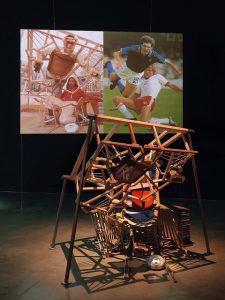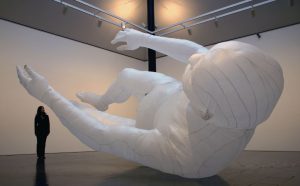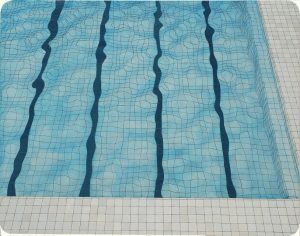June 30 (Saturday) – September 30 (Sunday), 2018
Galleries A, B and C at Hara Museum ARC
Sometime during the middle of the 20th century, Jean Tinguely began using waste materials and everyday items to create sculptural machines that moved, eventually becoming one of the leading proponents of kinetic art. Since ancient times, because of our constant proximity to light, wind, water and other elements of nature, we humans have continued to explore the nature of our senses and applied the power of our imaginations to endlessly represent the two diametric poles of movement and stillness. In this show, we exemplify these two themes with selected artworks by Tinguely and other artists in the Hara Museum Collection. We also feature an ambitious new work by Taro Izumi that was a focus of much attention at his solo show in Paris last year.
Talking paintings, moving sculptures, videos that are stopped–we invite you to come see the rich variety of contemporary art expression on the theme of “stop” and “go”.

[1] Taro Izumi, Tickled in a dream…maybe? (The cloud fell), 2017 The installation view at Palais de Tokyo, Paris, 2017 © Taro Izumi, courtesy of Take Ninagawa, Tokyo
Japanese debut of his large-scale installation presented last year at Palais de Tokyo, Paris
Tickled in a dream…maybe? is the name of a series of works (currently 11) that Taro Izumi began in 2014. This piece, cloud fell, premiered last spring at Izumi’s major solo exhibition at the Palais de Tokyo in Paris, seen by many as a temple of European contemporary art. Izumi attracted much attention for his unique works filled with humor and irony, most of which have already been purchased by museums and other institutions around the world. Thanks to an enthusiastic collector who wanted to “leave at least one of the series in Japan,” cloud fell was acquired and deposited with the Hara Museum. This show marks its first public display in Japan.
Born in 1976 in Nara Prefecture, Izumi received an MFA at Tama Art University in 2002. He currently lives in Tokyo. Izumi’s video works and dynamic video installations play on the ambiguous division between reality and fiction, stirring up questions about such relational concepts as seeing and being seen, photographing and being photographed. His works have appeared at many venues in Japan and abroad, including the Yokohama Triennale (2011) and Winter Garden: The Exploration of the Micropop Imagination in Contemporary Japanese Art (2009) and Mercedes-Benz Art Scope 2015-2017 (2017) at the Hara Museum of Contemporary Art. In 2017, he held the show Pan at the Palais de Tokyo, Paris, his first large-scale solo exhibition which garnered much critical attention. This was followed by the solo exhibition TARO IZUMI A Child Suddenly at the 21st Century Museum of Contemporary Art, Kanazawa.

[2] Max Streicher, Sleeping Giants (Silenus), 2002 ©Max Streicher
Streicher was born in Canada where he currently lives. He creates three-dimensional inflatable works that are vast in scale and also considered kinetic art. Despite its overwhelming presence inside the gallery, Streicher’s work seems to sway with a lightness that comes from its bulging air-filled girth. The title Sleeping Giants (Silenus) derives from the Roman myth of Sirenos, a servant deity to Dionysus who was always drunk. Indeed, Silenus is humorously presented as having fallen asleep in a drunken stupor while floating around like a balloon.

[3] Adriana Varejão, Swimming Pool, 2005 ©Adriana Varejaõ
Varejão was born in Brazil where she still lives. She has garnered critical attention throughout the world for works done in a variety of mediums, from oils to watercolor. Her show at the Hara Museum in 2007 was her first solo exhibition in Japan. This painting is part of a series of works that explore a theme that has occupied her in recent years: tiles in water. We see a close-up of a tiled poolside and the undulating water surface and feel something mysterious happening. What does this signify? It is an invitation to consider what lies behind the work.
Featured Artists
Taro Izumi / Minoru Ohira / Yayoi Kusama / Jean Tinguely / George Rickey / Jonathan Borofsky / Cindy Sherman / Tabaimo / Nam June Paik / Piotr Kowalski / Jesús-Rafael Soto / Hisayuki Mogami / Yukinori Yanagi / Robert Rauschenberg and others
Events
Artist Talk: Taro Izumi
Date: July 8 (Sunday), 2018
Time: 14:00 –
Participation fee: Free
This talk features Taro Izumi whose work appears in the exhibition Stop and Go. The artist will speak about the Japanese premier of his new work, as well as his past activities at the Hara Museum and other places around the world and his creative process.
Art is Fun!
Date: August 11 (Saturday), 12 (Sunday), 18 (Saturday) and 19 (Sunday)
Time: Five sessions at 10:30, 11:30, 13:00, 14:00 and 15:00 (each approx. 40 min. long)
Number of participants: 20 per session.
Participation fee: 540 yen
In this workshop, participants will make Uchiwa paper fans with washi paper.
*Museum admission will be required for the events.
*For reservations for the events, please write to Hara Museum ARC at arc@haramuseum.or.jp
Hara Museum ARC (Gunma)
Hara Museum ARC opened in 1988 in Shibukawa, Gunma prefecture as an annex to the Hara Museum of Contemporary Art in Tokyo (see box on the last page). Situated in the foothills of the Mt. Haruna, one of the so-called Jomosanzan or “Three Peaks of Jomo” (the old name of Gunma), the museum’s large-scale wooden buildings with their sleek black exteriors (designed by Arata Isozaki) stand in stark contrast to rich greens of the surrounding highland scenery. In addition to exhibitions centered on the museum’s permanent collection, Hara Museum ARC holds events, workshops and various art education programs. In 2008, an Open-view Storage and Kankai Pavilion were added as part of an expansion that has enabled Hara Museum ARC to serve as a capacious setting for art that transcends the boundaries of time and place.
Exhibition Details
Title: Stop and Go
Dates: June 30 (Saturday) – September 30 (Sunday), 2018
Venue: Gallery A, B and C at Hara Museum ARC
2855-1 Kanai, Shibukawa-shi, Gunma 377-0027
Tel 0279-24-6585 Fax 0279-24-0449 E-mail arc@haramuseum.or.jp
http://www.haramuseum.or.jp (official website) http://mobile.haramuseum.or.jp (mobile site) http://www.art-it.asia/u/HaraMuseum (blog) http://twitter.com/HaraMuseumARC (Twitter)
Hours: 9:30 am – 4:30 pm (last entry at 4:00 pm)
Organized by: Hara Museum of Contemporary Art
Closed: Thursdays (except during the month of August) *Subject to temporary closure in the event of severe weather.
Admission: General 1,100 yen, Students 700 yen (high school and university) or 500 yen (elementary and junior high), Free for Hara Museum members, 10% discount for a group of 20 or more, Combination ticket for Hara Museum ARC and Ikaho Green Bokujo (except during Golden Week): General 1,800 yen; Students 1,500 yen (high school and university) or 1,400 yen (junior high), 800 yen (elementary), half price for those over 70, discount for groups of 20 or more
*Children must be accompanied by an adult.
*For residents of Gunma Prefecture: Free admission for elementary and junior high school children every Saturday during the school term/200-yen-discount on admission for up to five persons upon presentation of the Guchoki Passport.
Directions: By train: Take the Joetsu Shinkansen to Takasaki, change to the Joestu Line, and disembark at Shibukawa. From Shibukawa, ARC is 10 minutes away by taxi or 15 minutes by bus (take the Ikaho Onsen bus to ″Green Bokujo Mae″). By car: 8 kilometers (about 15 minutes) from the Kan-etsu Expressway Shibukawa Ikaho Interchange (in the direction of Ikaho Onsen).
*Visitors can view the on-going exhibitions Dynamism and Stillness (Kankai Pavilion) as well.
Concurrent Exhibition
Dynamism and Stillness at Kankai Pavilion (Traditional East Asian Art)
Part I: June 30 (Saturday) – August 23 (Thursday), 2018
Part II: August 24 (Friday) – September 30 (Sunday), 2018
